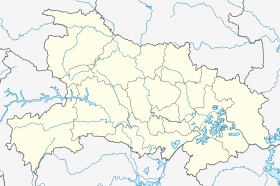Danjiangkou
Danjiangkou (Chinese: 丹江口; pinyin: Dānjiāngkǒu) is a county-level city in northwestern Hubei, China, bordering Henan province to the northeast. The city spans an area of 3,121 square kilometers, and has a population of approximately 478,000 as of 2017.[2]
Danjiangkou 丹江口市 | |
|---|---|
Zixiao Palace | |
 Danjiangkou Location in Hubei | |
| Coordinates (Danjiangkou municipal government): 32°32′24″N 111°30′47″E | |
| Country | People's Republic of China |
| Province | Hubei |
| Prefecture-level city | Shiyan |
| Area | |
| • County-level city | 3,121 km2 (1,205 sq mi) |
| • Urban | 214.94 km2 (82.99 sq mi) |
| Population (2010)[1] | |
| • County-level city | 443,755 |
| • Estimate (2017)[2] | 478,000 |
| • Density | 140/km2 (370/sq mi) |
| • Urban | 209,300 |
| Time zone | UTC+8 (CST) |
| Website | djk |
Geography
Danjiangkou is located where the Dan River flows into the Han River.[3]
The city proper is situated near the Danjiangkou Dam on this river.
History
The area of present-day Danjiangkou belonged to both the Han and the Chu during the Warring States period.[1] After the Warring States period, the area was conquered by the Qin dynasty, which administered the area as Wudang County (武当县; 武當縣), after the nearby Wudang Mountains.[1] Wudang County belonged to the Nanyang Commandery.[1] In 208 CE, the area formed part of the newly established Nanxiang Commandery.[1] In 289 CE, under the Jin Dynasty, the area formed part of the newly established Shunyang Commandery.[1] During the Yongjia rebellion, many refugees from present-day Linfen, Shanxi settled in Wudang County.[1] In 618 CE, Wudang County became part of the newly formed Wudang Commandery (武当郡; 武當郡).[1] In 1119, Wudang Commandery became the Wudang Jun (武当军; 武當軍).[1] In 1276, the Wudang Jun became the Jun Prefecture.[1] In 1476, the area was merged into Xiangyang Fu.[1]
The area remained part of the Jun Prefecture until the establishment of the Republic of China in 1912, which re-organized the Jun Prefecture as Jun County (均县; 均縣).[1] In May 1914, Jun County was assigned to Hubei Circuit.[1] In 1932, it was moved to the province's 11th Administrative Circuit, and was moved to the province's 8th Administrative Circuit in 1936.[1]
On March 21, 1948, the county seat was taken by the People's Liberation Army, and the rest of the county was taken by March 28.[1] On June 2, the Jun County Democratic County Government was established by the Communist Party.[1] With the foundation of the People's Republic of China on October 1, 1949, the county's government was renamed to the Jun County People's Government.[1]
Jun County was briefly revoked in July 1960, and was merged into Guanghua County, before being re-established in 1962.[1] On August 19, 1983, Jun County became the county-level city of Danjiangkou.[1]
Administrative divisions
Danjiangkou is divided into 4 subdistricts, 12 towns, and 5 other township-level divisions.[4][5] These are subsequently divided into 41 residential communities and 223 administrative villages.[5]
The city's 4 subdistricts are Junzhou Road Subdistrict, Daba Road Subdistrict, Danzhao Road Subdistrict, and Sanguandian Subdistrict.[4][5]
The city's 12 towns are Tuguanya, Langhe, Dingjiaying, Liuliping, Yanchihe, Junxian, Xijiadian, Haoping, Shigu, Liangshuihe, Guanshan, and Longshan.[4][5]
The city's 5 other township-level divisions are Xingang Economic Development Management Area, Niuhe Forestry Development Management Area, Baiyangping Forestry Development Management Area, Dagou Forestry Development Management Area, and Wudangshan Tourism Economic Special Zone.[4][5]
Economy
In 2017, the city's GDP totaled ¥22.514 billion, the government budget totaled ¥2.089 billion, and foreign trade totaled USD 40.7918 million.[3]
Tourism
The city received 14.91 million tourists in 2017.[3] The Wudang Mountains, which run through the city, have been designated as a 5A Tourist Attraction.[3] The Danjiangkou Reservoir is also a major tourist attraction, and hosts watersports events and serves as a popular fishing spot.[3]
Transport
The Xiangyang–Chongqing railway and the Wuhan–Shiyan Expressway both run through the city.[3] Portions of the Wuhan–Shiyan high-speed railway and the Shiyan-Xichuan Expressway (十淅高速; Shí–Xī Gāosù) are under construction within Danjiangkou as of July 2020.[3]
Danjiangkou is the northwest terminus of the Hankou–Danjiangkou Railway.
External links
References
- 丹江口市历史沿革 [Danjiangkou City Historical Development] (in Chinese). XZQH.org. 2014-08-06. Archived from the original on 2020-07-28. Retrieved 2020-07-28.
- Ministry of Housing and Urban-Rural Development, ed. (2019). China Urban Construction Statistical Yearbook 2017. Beijing: China Statistics Press. p. 66. Retrieved 11 January 2020.
- 丹江口概况 [Danjiangkou Overview] (in Chinese). Danjiangkou People's Government. 2020-07-09. Archived from the original on 2002-07-28. Retrieved 2002-07-28.
- 2019年统计用区划代码和城乡划分代码:丹江口市 [2019 Statistical Area Numbers and Rural-Urban Area Numbers: Danjiangkou City] (in Chinese). National Bureau of Statistics of the People's Republic of China. 2019. Archived from the original on 2020-07-28. Retrieved 2020-07-28.
- 区划人口 [Administrative Divisions & Population] (in Chinese). Danjiangkou People's Government. 2020-07-27. Archived from the original on 2020-07-28. Retrieved 2020-07-28.